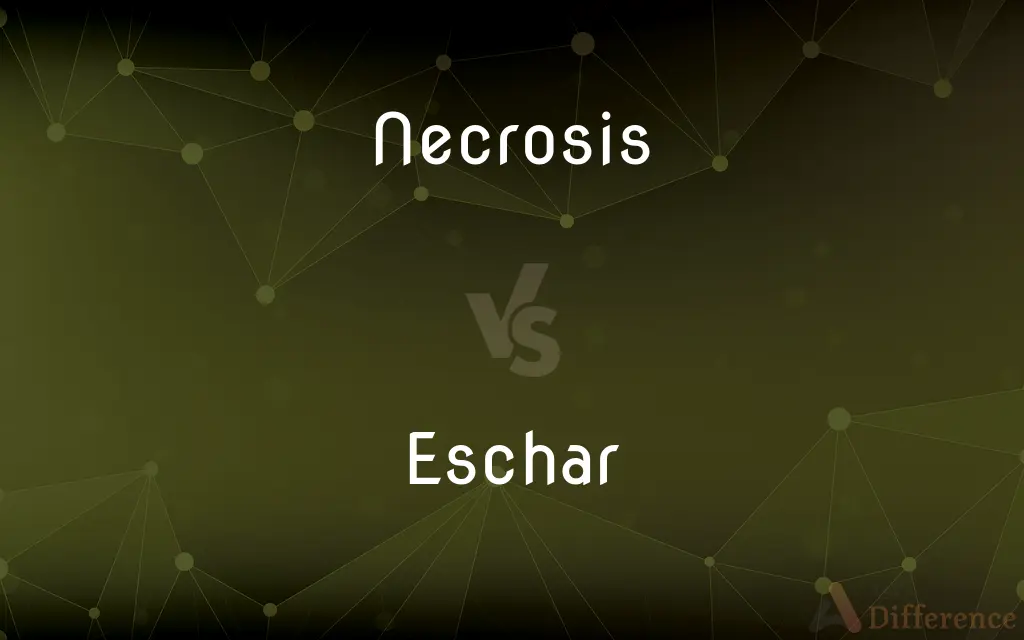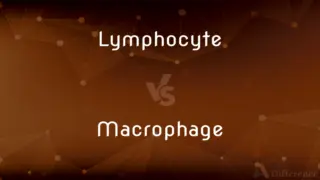Necrosis vs. Eschar — What's the Difference?
By Tayyaba Rehman & Fiza Rafique — Updated on March 13, 2024
Necrosis is the death of body tissue, while eschar is a dry, dark scab or falling away of dead skin typically formed after a burn or wound.

Difference Between Necrosis and Eschar
Table of Contents
ADVERTISEMENT
Key Differences
Necrosis refers to the death of cells or tissues in the body due to factors such as infection, toxins, trauma, or lack of blood supply (ischemia). It is characterized by the breakdown of tissue structure, leading to the affected area becoming black, brown, or greenish due to the breakdown of hemoglobin in the blood. Eschar, on the other hand, specifically refers to a slough or piece of dead tissue that is cast off from the surface of the skin, particularly after a burn, injury, or the presence of a gangrenous infection.
Necrosis can occur in any tissue and is associated with various conditions, including infections, chronic diseases, and acute injuries. It is considered an uncontrolled and pathological process, often resulting in inflammation and can lead to further complications if not properly managed. In the context of wound care, the presence of eschar often requires careful management to prevent infection and promote healing. In some cases, eschar may need to be surgically removed (debridement) to allow for better wound healing.
While necrosis is a broader term for the death of tissue due to various causes, eschar is a more specific term referring to the dead tissue that results from a particular kind of injury or skin condition. The formation of eschar can be a part of the necrotic process, especially in cases of severe skin injuries or conditions that result in significant tissue death.
The management of necrosis and eschar involves addressing the underlying cause of the tissue death, ensuring proper wound care, and in some cases, surgical intervention to remove dead tissue. Both conditions highlight the importance of timely and effective medical treatment to prevent complications and promote healing.
Comparison Chart
Definition
The pathological death of cells or tissues in the body due to various causes.
A dry, dark scab or piece of dead tissue cast off from the skin, often following a burn or wound.
ADVERTISEMENT
Causes
Infection, toxins, trauma, ischemia.
Burns, severe wounds, gangrene.
Appearance
Affected area may become black, brown, or greenish.
Typically dry, dark (black or brown), and leathery.
Process
Uncontrolled and pathological, leading to tissue breakdown.
Natural protective barrier over a wound, resulting from the death of surface tissue.
Management
Addressing underlying cause, inflammation control, possible surgical removal.
Wound care, infection prevention, possible debridement.
Compare with Definitions
Necrosis
The pathological death of tissue in the body.
Due to the severe infection, necrosis set in, leading to tissue death in the affected area.
Eschar
A dry, dark scab formed on the skin after a burn or injury.
After the burn, an eschar formed over the wound, providing a natural protective covering.
Necrosis
Characterized by cell or tissue breakdown.
Necrosis in the wound was evident by the discolored and deteriorating tissue.
Eschar
Acts as a barrier to infection for the underlying wound.
The presence of eschar helped prevent infection in the early stages of wound healing.
Necrosis
Can lead to serious health complications if untreated.
Untreated necrosis can lead to systemic infections and other critical conditions.
Eschar
May require debridement for optimal healing.
The doctor decided to perform debridement to remove the eschar and promote better healing.
Necrosis
Often results from lack of blood supply or injury.
The limb underwent necrosis after the prolonged restriction of blood flow.
Eschar
Represents dead tissue that sloughs off from the skin.
The eschar eventually detached from the skin as the underlying tissue began to heal.
Necrosis
Managed through medical intervention and sometimes surgical removal.
To prevent the spread of necrosis, the dead tissue had to be surgically removed.
Eschar
Associated with burns, gangrene, and some skin infections.
In cases of severe gangrene, eschar formation is a common occurrence.
Necrosis
Necrosis (from Ancient Greek νέκρωσις, nékrōsis, "death") is a form of cell injury which results in the premature death of cells in living tissue by autolysis. Necrosis is caused by factors external to the cell or tissue, such as infection, or trauma which result in the unregulated digestion of cell components.
Eschar
An eschar (; Greek: eschara) is a slough or piece of dead tissue that is cast off from the surface of the skin, particularly after a burn injury, but also seen in gangrene, ulcer, fungal infections, necrotizing spider bite wounds, tick bites associated with spotted fevers and exposure to cutaneous anthrax. The term ‘eschar’ is not interchangeable with ‘scab’.
Necrosis
Death of cells through injury or disease, especially in a localized area of a tissue or organ.
Eschar
A dry scab or slough formed on the skin as a result of a burn or by the action of a corrosive or caustic substance.
Necrosis
(pathology) The localized death of cells or tissues through injury, disease, or the interruption of blood supply.
Eschar
(medicine) A superficial structure of dead tissue, usually hardened, commonly, but not necessarily dark, adhering to underlying living or necrotic tissue, caused by gangrene or a burn.
Necrosis
The pathologic death of part of a tissue due to irreversible damage. Contrast to necrobiosis, which is a normal death of cells in a tissue. Formerly, applied primarily to death of bone tissue.
Eschar
(loose or obsolete) Any hard, dark, commonly flattened or sunken lesion or crust, especially on a burn, abscess, infection, wound; commonly a coagulation of blood or exudations, not necessarily involving dead or necrotic tissue.
Necrosis
A disease of trees, in which the branches gradually dry up from the bark to the center.
Eschar
(figurative or literary) The emotional imprint of a trauma such as grief, loss, or degradation.
Necrosis
The localized death of living cells (as from infection or the interruption of blood supply)
Eschar
A dry slough, crust, or scab, which separates from the healthy part of the body, as that produced by a burn, or the application of caustics.
Eschar
In Ireland, one of the continuous mounds or ridges of gravelly and sandy drift which extend for many miles over the surface of the country. Similar ridges in Scotland are called kames or kams.
Eschar
A dry scab formed on the skin following a burn or cauterization of the skin
Common Curiosities
Can eschar develop without necrosis?
Eschar is typically a result of necrosis in the superficial layers of the skin, so it is usually associated with some form of necrotic process.
How is necrosis treated?
Treatment involves addressing the underlying cause, controlling inflammation, and possibly removing the necrotic tissue surgically.
How can necrosis be prevented?
Preventing necrosis involves managing risk factors, such as ensuring adequate blood flow, avoiding injuries, and prompt treatment of infections.
Does eschar always need to be removed?
Not always; the decision to remove eschar depends on the wound's healing stage, the risk of infection, and the overall health of the surrounding tissue.
When is debridement necessary for eschar?
Debridement might be necessary when eschar hinders the healing process or there's a risk of infection beneath the eschar.
What are the complications associated with necrosis and eschar?
Complications can include infection, delayed wound healing, and in severe cases, systemic illness or the need for surgical intervention such as amputation.
Is eschar formation a good or bad sign?
Eschar formation can be part of the natural healing process, providing a protective barrier; however, its presence requires careful wound management to prevent complications.
What is the main difference between necrosis and eschar?
Necrosis is the process of tissue death, while eschar specifically refers to the dead, dry tissue that forms over a wound, usually after a burn.
Is eschar a sign of infection?
Eschar itself is not an infection, but it can be a sign of underlying tissue damage that could be susceptible to infection if not properly managed.
Can necrosis lead to amputation?
In severe cases, especially if necrosis is widespread and affects deeper tissues or limbs, amputation might be necessary to prevent the spread of infection.
Share Your Discovery

Previous Comparison
Peritoneum vs. Retroperitoneum
Next Comparison
Lymphocyte vs. MacrophageAuthor Spotlight
Written by
Tayyaba RehmanTayyaba Rehman is a distinguished writer, currently serving as a primary contributor to askdifference.com. As a researcher in semantics and etymology, Tayyaba's passion for the complexity of languages and their distinctions has found a perfect home on the platform. Tayyaba delves into the intricacies of language, distinguishing between commonly confused words and phrases, thereby providing clarity for readers worldwide.
Co-written by
Fiza RafiqueFiza Rafique is a skilled content writer at AskDifference.com, where she meticulously refines and enhances written pieces. Drawing from her vast editorial expertise, Fiza ensures clarity, accuracy, and precision in every article. Passionate about language, she continually seeks to elevate the quality of content for readers worldwide.














































